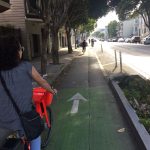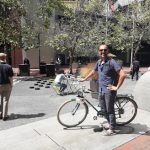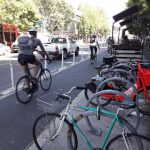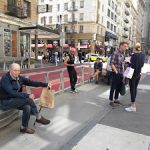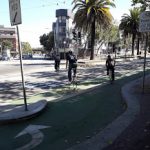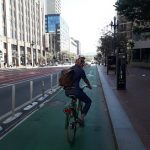This report was included in my monthly Chair’s report on the Waitemata Local Board July business meeting agenda.
Report back from Velo-city conference: Access to Life
 I was fortunate to attend and present at the annual Velo-city Summit 2018, a premier international conference on cycling and urban mobility.
I was fortunate to attend and present at the annual Velo-city Summit 2018, a premier international conference on cycling and urban mobility.
Velo-city conferences bring together those involved in policy, promotion and the provision of cycling facilities and programs. Engineers, planners, architects, social marketers, academic researchers, environmentalists, business, and industry representatives join forces with government at all levels ranging from municipal politicians, policy makers and educators in knowledge sharing in order to build effective trans-national partnerships to deliver benefits worldwide.
Velo-city 2018 Rio focused on the main theme Access to Life, linked to the overall goal of cycling inclusion. Building on topics of previous Velo-city conferences such as Health, Infrastructure, Technology, Governance and Data, Velo-city in Rio explored the fusion of these discourses through cycling inclusion.
I found Velo-city to be energising, informative and inspiring. I have previously attended Velo-city 2014 in Adelaide. At that time, it seemed as if Auckland had reached a tipping point, but still had a long way to go to catch up with cities that had embraced cycling as a legitimate mode of transport. Four years later I was able to present the Auckland story (surprising many people with the progress that has been made) and found it encouraging to have it confirmed that Auckland is on the right path to a sustainable, smart city.
As highlighted at the conference the benefits for all of investing in cycling are overwhelming. Attending the conference reinforced for me that we’re now at a stage in Auckland where we know why we need to do it, we’ve heard from plenty of overseas experts how we need to do it, we have the funding confirmed, community support and the political will – we just have to get on with it!
My top take outs from the conference:
 Access to life The bicycle can literally mean access to life for communities around the world. We heard from Mozambique where a bike can save 3 hours of walking to access water (photo right: Rui Mesquita, CEO of Mozambikes). In Chicago a bike is a vehicle for community transformation and provides benefits such as reducing violence and the creation of jobs (opening plenary speaker: Oplatunji Oboi Reed from Equicity, Chicago). In Brazil bikes are empowering black women and creating the conditions for gender equality (Livia Suárez Founder of La Frida Bike Café, Preta vem de bike and Casa La Frida – photo right- and Jamila Santana, Artistic Coordinator of La Frida Bike ). Access to life can also be achieved for children by
Access to life The bicycle can literally mean access to life for communities around the world. We heard from Mozambique where a bike can save 3 hours of walking to access water (photo right: Rui Mesquita, CEO of Mozambikes). In Chicago a bike is a vehicle for community transformation and provides benefits such as reducing violence and the creation of jobs (opening plenary speaker: Oplatunji Oboi Reed from Equicity, Chicago). In Brazil bikes are empowering black women and creating the conditions for gender equality (Livia Suárez Founder of La Frida Bike Café, Preta vem de bike and Casa La Frida – photo right- and Jamila Santana, Artistic Coordinator of La Frida Bike ). Access to life can also be achieved for children by  making cities child friendly “A city envisioned through the eyes of children is likely to be a bike city not one for cars” (Eliana Riggio, International Child Friendly Cities Secretariat at the UNICEF Innocenti Research Centre, in Florence)
making cities child friendly “A city envisioned through the eyes of children is likely to be a bike city not one for cars” (Eliana Riggio, International Child Friendly Cities Secretariat at the UNICEF Innocenti Research Centre, in Florence)
It is so much more than just the bicycle The focus of debate that I often hear in Auckland is whether people personally want to cycle that is often framed misleadingly as an attack on those wishing to drive. The conference reinforced for me that cycling is part of a far bigger response to the challenges of our time. When a city provides its citizens with viable access to cycling as mobility it creates an environment for everyone that is healthier, more sustainable, less polluting and acts as a generator of happiness.
Just to give one example that was highlighted at the Global Policy panel discussion session. The obesity crisis is a bigger problem world wide than malnutrition. To add healthy activity to daily lives walking and cycling must be must be a “hidden” physical activity.
 A city for everyone A common theme from speakers across the conference was the need to prioritise inclusion in transport planning so that the city works for everyone. Rubbish infrastructure such as poor-quality footpaths is a huge barrier. For example Rafaella Basile from Cidade Ativa gave an overview of problems pedestrians face in Brazil – lack of infrastructure, insufficient width, surface quality or lack of maintenance. She stressed that insufficient pedestrian infrastructure harms the most vulnerable part of society.
A city for everyone A common theme from speakers across the conference was the need to prioritise inclusion in transport planning so that the city works for everyone. Rubbish infrastructure such as poor-quality footpaths is a huge barrier. For example Rafaella Basile from Cidade Ativa gave an overview of problems pedestrians face in Brazil – lack of infrastructure, insufficient width, surface quality or lack of maintenance. She stressed that insufficient pedestrian infrastructure harms the most vulnerable part of society.
Getting the infrastructure right can promote social inclusion, accessibility and equity.
In Auckland the barriers to children walking and cycling to school has been recently highlighted by the AA. Their surveys found that Auckland parents and some schools actively discourage children from walking and cycling to school due to a lack of safety infrastructure.
 Mixing up mobility The transport sector likes to refer to “intermodal” to describe getting around by difference conveyances. It would be great to come up with a new term as I don’t think a session at the conference on “intermodality” really explains itself to most people (at least not in the Auckland context anyway). However, what it aims to achieve when mixed up with cycling is worth signing up for. As Pascal Smet the Minister of mobility in Brussels highlighted it is about moving away from a city for cars to a city for people “We need
Mixing up mobility The transport sector likes to refer to “intermodal” to describe getting around by difference conveyances. It would be great to come up with a new term as I don’t think a session at the conference on “intermodality” really explains itself to most people (at least not in the Auckland context anyway). However, what it aims to achieve when mixed up with cycling is worth signing up for. As Pascal Smet the Minister of mobility in Brussels highlighted it is about moving away from a city for cars to a city for people “We need  to talk about objectives, not about the means”
to talk about objectives, not about the means”
From a number of speakers we heard the many ways in which the integration of high quality public transport, transport orientated design, bike parking, bike share and quality cycle highways can increase the range of riders can travel and the number of people cycling.
The presentation on Brussels had some great before and after photos (eg the car park transformation above) very similar to projects we are working on in Auckland such as repurposing the Eastern Viaduct car park into a new plaza and removal of the Dominion Road flyover.
 Build it and they will come, but we’ve got to get on with it There were many technical experts at the conference particularly from the Dutch Cycling Embassy and the Danish Cycling Embassy. They can boast impressive infrastructure resulting in a high proportion of people cycling for transport. As is well known the key to achieving this is a network of high quality safe, separated cyclepath.
Build it and they will come, but we’ve got to get on with it There were many technical experts at the conference particularly from the Dutch Cycling Embassy and the Danish Cycling Embassy. They can boast impressive infrastructure resulting in a high proportion of people cycling for transport. As is well known the key to achieving this is a network of high quality safe, separated cyclepath.
However the presenters took care to note that cities like Amsterdam and Copenhagen were not always great places to cycle. They just got started a lot earlier to re-prioritise road space. Photo right: Mirjam Borsboom from the Dutch Cycling Embassy showing a “before” example. The Netherlands started on the path to embracing cycling in the 70’s after the “Stop child murder” campaign.
Mirjam was also generous to say that the Dutch had things to learn from other places such as on her visit to Auckland with the Embassy last year.
The importance of a Vision Zero framework – starting with slower speeds
Road fatalities are the first cause of death for 5-9 years olds worldwide killing a total of 1.3 million people annually. In a presentation on Vision Zero we heard that Mexico City are adopting an approach of putting the safety of children first. (Clara Vadillo Quesada, from “Vision Zero for youth” in Mexico City) Clara presented examples of tactical urbanism using paint to improve the safety of school zones (quick, cheap, effective methods that we sometimes struggle to do in Auckland).
 In Auckland and New Zealand we are on the verge of adopting Vision Zero to address our road safety crisis of increasing deaths and serious injuries (In the past three years, Auckland deaths and serious injuries have increased at almost triple the rate of the rest of NZ and around five times the growth of travel). I was interested to hear more about Sweden’s ‘Moving beyond Vision Zero campaign that was launched in 2017. As presented by Lars Strömgren, ECF Vice-President (photo right) Sweden, aims to encourage traffic planners and transport decision makers around the world to improve upon the 20-year-old campaign “Vision Zero” by factoring in the health benefits of active transport. A new goal should lead to traffic that saves lives and improves quality of life in addition to reducing traffic fatalities and injuries by promoting active mobility in the form of cycling and walking (ie not implementing vision zero to make safety improvements on roads that make it less attractive to walk and cycle)
In Auckland and New Zealand we are on the verge of adopting Vision Zero to address our road safety crisis of increasing deaths and serious injuries (In the past three years, Auckland deaths and serious injuries have increased at almost triple the rate of the rest of NZ and around five times the growth of travel). I was interested to hear more about Sweden’s ‘Moving beyond Vision Zero campaign that was launched in 2017. As presented by Lars Strömgren, ECF Vice-President (photo right) Sweden, aims to encourage traffic planners and transport decision makers around the world to improve upon the 20-year-old campaign “Vision Zero” by factoring in the health benefits of active transport. A new goal should lead to traffic that saves lives and improves quality of life in addition to reducing traffic fatalities and injuries by promoting active mobility in the form of cycling and walking (ie not implementing vision zero to make safety improvements on roads that make it less attractive to walk and cycle)
What was also emphasised by other speakers is that where there is no separated infrastructure the best safety tool is to reduce speeds to 30km on residential streets. Work is underway on Speed Management Plans for Auckland that will bring in long overdue speed reductions.
 Cycling as “new” technology The technology plenary session discussion at the conference was excellent for providing insight about what is happening right now at the front line and how cycling can be considered “new” technology.
Cycling as “new” technology The technology plenary session discussion at the conference was excellent for providing insight about what is happening right now at the front line and how cycling can be considered “new” technology.
Tim Papandreou, former Chief Innovation Officer with the City of San Francisco, Transportation Agency with experience working on Waymo (Google’s autonomous vehicle project) spoke to the sunsetting of traditional transport as technology changes (where don’t need drivers operating systems in the same way people have been removed from operating machinery) and how the bicycle fits into the platform of tech and a menu of transport choices.
 Ninna Hedeager Olsen, Senior of Technical and Environmental Affairs at the City of Copenhagen (photo left) took a no nonsense approach to technology. Her city is adopting leading Intelligent Transport Solutions for mobility, especially some of the unique innovations for cyclists’ traffic management. “Technology should make lives better for people, not be a goal in itself, and although low-tech, the bike is very effective in Copenhagen”
Ninna Hedeager Olsen, Senior of Technical and Environmental Affairs at the City of Copenhagen (photo left) took a no nonsense approach to technology. Her city is adopting leading Intelligent Transport Solutions for mobility, especially some of the unique innovations for cyclists’ traffic management. “Technology should make lives better for people, not be a goal in itself, and although low-tech, the bike is very effective in Copenhagen”
Kevin Mayne, Development Director at ECF, stressed the importance of cycling advocates and policy makers engaging with the emerging policy challenges and not leaving it all to the automotive sector to dictate. He sees cycling as part of “new” tech with the opportunities coming from bike  sharing and ebikes to play a role in Mobility as a service (MAAS). However, the first question to ask is “where is the walking”?
sharing and ebikes to play a role in Mobility as a service (MAAS). However, the first question to ask is “where is the walking”?
I took away from the discussion the need for Auckland to identify the problem we are trying to solve and to create and dictate the space that technology is invited into. As Tim cautioned “AV technology has no moral compass” so AV tech will just go where it is allowed to go.
Blast them with data Tim also took part in the interesting Big Data session with Philippe Crist, Strategic Advisor for Innovation and Foresight, International Transport Forum at the OECD facilitated by Kevin Mayne.
Philippe strongly emphasised the need to start with “Why do you need the data?” in order to make good decisions about what data is requested from companies. Cycling gets overlooked because not “big transport” and traditionally detected. An issue that AV tech looking to solve however he warned against accepting a solution of “tagging” riders (or walkers). He also provided a warning about the in built data bias because of the different economic profile of owners of Apple or Android smartphones which can distort analysis. Cycling at all levels has to get into the Big Data space and engage, in order to create data that works for our needs. As Philippe said “Don’t wait to be invited into the room, we have to create our own room where the technology people talk to us”.
Tim also spoke of the need for a city to establish first “What data is wanted for” to avoid a power struggle for data particularly where there are privacy concerns. However, the good news is that data science is changing fast so there are ways of extracting data without revealing personal information.
 Tim provided some very practical and relevant advice about how best to use data to sell an idea. When advising decision makers, he starts with the story-telling rather than the data because we’re all emotional and that is what we respond to. However, he puts this firmly in the context of the decision makers’ own agreed strategic framework backed up with data. Tim showed me the direct result of this approach on a tour of San Francisco at the end of my trip (see below). Safety inventions like kerb build outs are now going ahead without push back because San Francisco has adopted Vision Zero and they have the crash stats to identify dangerous intersections where intervention is required (eg photo right of a temporary safety measure).
Tim provided some very practical and relevant advice about how best to use data to sell an idea. When advising decision makers, he starts with the story-telling rather than the data because we’re all emotional and that is what we respond to. However, he puts this firmly in the context of the decision makers’ own agreed strategic framework backed up with data. Tim showed me the direct result of this approach on a tour of San Francisco at the end of my trip (see below). Safety inventions like kerb build outs are now going ahead without push back because San Francisco has adopted Vision Zero and they have the crash stats to identify dangerous intersections where intervention is required (eg photo right of a temporary safety measure).
 Cashing in on the economic benefits: We heard more on the overwhelming evidence that investment in cycling reaps economic benefits (eg Shopping by bike session). Cycle tourism is more lucrative in Europe than the cruise ship industry (and less polluting). 650,000 jobs are as a result of the cycling industry (more than mining and quarrying). From one study a 1 Euro investment has resulted in 35 Euros of benefit (Economic Benefits ECF research). I plan on following up with ATEED (Auckland’s economic development organisation) to find out what work they’re doing to promote cycle tourism.
Cashing in on the economic benefits: We heard more on the overwhelming evidence that investment in cycling reaps economic benefits (eg Shopping by bike session). Cycle tourism is more lucrative in Europe than the cruise ship industry (and less polluting). 650,000 jobs are as a result of the cycling industry (more than mining and quarrying). From one study a 1 Euro investment has resulted in 35 Euros of benefit (Economic Benefits ECF research). I plan on following up with ATEED (Auckland’s economic development organisation) to find out what work they’re doing to promote cycle tourism.
In Vienna the largest shopping street has been transformed for walking and cycling. The opposition evaporated once opened due to the big lift in economic activity (photo right Robert Pressl, Project coordinator, CIVITAS). ). This was described as a “Lighthouse” project. I think Karangahape enhancement project will come to be viewed in exactly the same way once finally completed.
Auckland’s story “I’ll just take the bike”
 I presented as part of a session Cities for people? Rethinking Urban Planning together with Mirjam Borshboom from the Dutch Cycling Embassy and Firoza Suresh from the Smart Commute Foundation, India . The session explored the necessity to refocus our planning away from a planning model based on individual motorized transport towards people-centre low-carbon sustainable mobility systems.
I presented as part of a session Cities for people? Rethinking Urban Planning together with Mirjam Borshboom from the Dutch Cycling Embassy and Firoza Suresh from the Smart Commute Foundation, India . The session explored the necessity to refocus our planning away from a planning model based on individual motorized transport towards people-centre low-carbon sustainable mobility systems.
My presentation outlined how in Auckland we’re making the thought “I’ll just take the bike” a reality for Aucklanders and considered how far we are actually rethinking our urban planning.
A number of people approached me after the presentation to say how surprised and impressed they were to see the progress made in Auckland. I was proud to represent Auckland at the conference.
Summing up the conference
The conference was spread over four days with too many presentations to attempt to sum up (check out the ECF website for the full write up about the conference). In addition to the key themes I found it really inspiring to hear from people working in really challenging places to bring about better conditions for people to ride bikes. For example Nikita Lalwani, the Bicycle Mayor of Baroda in Gujarat, India (appointed in May 2017 by BYCS, a Dutch NGO) who promotes cycling in a city with huge congestion but no cycle facilities. She does it because commuting by bike is still healthier and more convenient for her.
 I enjoyed hearing about the compost business powered by a cargo bike and creating jobs (photo right). This is exactly what we need to be looking at in Auckland. The conference was an amazing opportunity to meet people from around the world doing really interesting things to create the conditions to encourage cycling such as Sile Ginnane from Liberty Bell in Dublin using a citizen-led low cost auditing system to gather qualitative data about the cycling and walking environment.
I enjoyed hearing about the compost business powered by a cargo bike and creating jobs (photo right). This is exactly what we need to be looking at in Auckland. The conference was an amazing opportunity to meet people from around the world doing really interesting things to create the conditions to encourage cycling such as Sile Ginnane from Liberty Bell in Dublin using a citizen-led low cost auditing system to gather qualitative data about the cycling and walking environment.
The conference was not without its controversies. Participants from developing countries received a discounted registration that was still well beyond the means of average Brazillians. The sessions were by a diverse range of speakers that wasn’t reflected in the make up of participants.
 The cycling parade is a highlight of every Velo-city (photo right) but it wasn’t so great for the locals who had to put up with central streets being shut down for our convenience and enjoyment.
The cycling parade is a highlight of every Velo-city (photo right) but it wasn’t so great for the locals who had to put up with central streets being shut down for our convenience and enjoyment.
From a visitor perspective it was amazing to experience Rio and the spectacular waterfront ride. On my trip I also enjoyed waterfront rides in Montevideo, Palma, Seattle and San Francisco. It highlighted the huge potential to transform Auckland’s waterfront along Tamaki Drive into an even better mecca for tourists and locals.
I’m grateful for the opportunity to attend the conference (made possible by the generous airfare gift from a friend) and to have met so many amazing people. I was able to explore new ideas and come home equipped with the questions to ask to ensure we deliver best practice.
 Joke told by one of the speakers: How do you recognize a cycle path in Germany? There is a car parked in it.
Joke told by one of the speakers: How do you recognize a cycle path in Germany? There is a car parked in it.
(sound familiar Auckland? Photo credit: Bike Auckland)
Presentation summaries
There are excellent write- ups of many of the speakers on the European Cycling Federation website. I acknowledgement the assistance of referring to these summaries in writing up my report.
Attendance costs
- Conference registration $NZ870.00 – covered by Auckland Transport (the abstract for my presentation was originally submitted by Auckland Transport)
- Accommodation (3 of 5 nights) $NZ432 – covered by Auckland Council
- Airfare – a birthday gift from a friend
- All other expenses – transfers, accommodation (2 nights), meals etc – personal cost
Velocity Conference Side Event: The Big Picture: A Safe System for Cycling in Cities
At Velo-city I met Anna Bray Sharpin, a Kiwi based in Washington DC who works for World Resources Institute. She invited me to present my Auckland case study at a conference side event. Participants were from 12 developing countries with the potential to incorporate cycling as part of transport solutions.
 Melinda Hanson from NACTO (National Association of Transportation Officials) gave an excellent presentation on Strategies for Scaling up Cycling. Her 10 points summarizing the politics of “How” are really relevant to Auckland right now.
Melinda Hanson from NACTO (National Association of Transportation Officials) gave an excellent presentation on Strategies for Scaling up Cycling. Her 10 points summarizing the politics of “How” are really relevant to Auckland right now.
1. Show it works
2. Measure & promote
- Bike counts
- Economic benefits – speak to what politicians need to hear
- Use new technology to track metrics eg origins and destinations
3.Reach out – move away from images of people on bikes wearing helmets to humanize cyclists
4.Support allies – eg bike advocates
5. Emphasise safety with a focus on speed reduction
6. Make cycling mainstream
7. Leverage the private sector – eg dockless bike share
8.Think about cycling as a big infrastructure project. Will be more eligible for multi funding
9. Be bold (Auckland’s Te ara I whiti/Lightpath was used as the example in Melinda’s presentation – photo above)
10. Don’t back down – example of Seville (StreetFilms: How Sevilla got its cycle network) that demonstrates the importance of a bold vision (18km network built within 18 months for 32m Euros to achieve 8% mode share). Know there will be push back but trust the process and the outcome.
Checking it out up close – cycling tour of San Francisco
On route back from my trip I stopped off in San Francisco and was treated by Tim Papandreau to a tour of cycling infrastructure that is transforming the city and significantly increasing cycling numbers.


